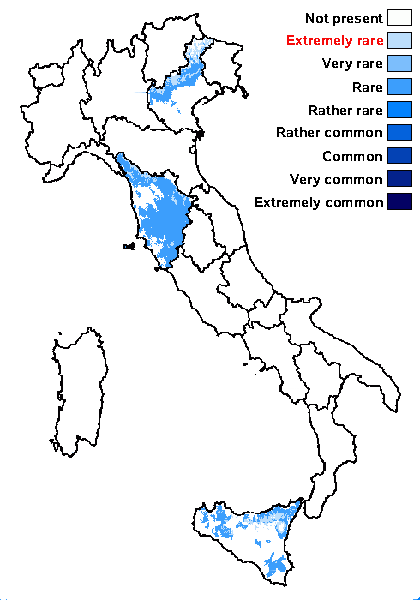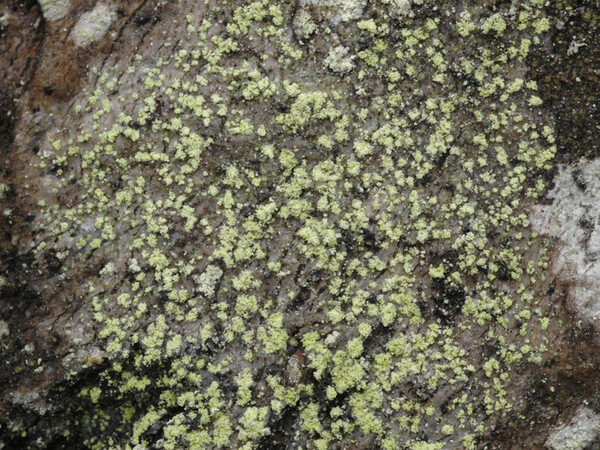Rinodina efflorescens Malme
Svensk Bot. Tidskr., 21: 251, 1927.
Synonyms: Lecanora hueana Harm.; Rinodina hueana (Harm.) H. Olivier nom. illegit. non Vain.
Distribution: N - Ven (Thor & Nascimbene 2007). C - Tosc. S - Si (Nimis & al. 1996b).
Description: Thallus crustose to subsquamulose, episubstratic, usually forming small irregular patches, areolate, sorediate, usually without a distinct prothallus. Areoles grey-brown to green-brown, matt, usually scattered, irregularly rounded, often somewhat divided, flat to distinctly convex, often free from the substratum towards the margin, 0.25‑0.8(-1.20) mm wide. Soralia bursting from the areoles, brown, greyish brown or dull greenish yellow, punctiform, more or less flat, up to 0.15 mm in diam, the soredia farinose, 12-30 μm in diam., sometimes a few gathered in larger, rounded consoredia; external soredia sometimes distinctly brown, the brown pigment K+ fuscous brown, N-. Apothecia rare, lecanorine, 0.3-0.5 mm across, with a dark reddish brown to black-brown, flat disc and a usually esorediate, sometimes finally excluded thalline margin; a parathecial ring is often evident as well. Thalline exciple 50‑110 µm wide in lower part, the cortex to 10‑40(‑80) µm thick; proper exciple colourless to brownish, 5-10 µm wide laterally (in clearly lecanorine apothecia), or 40‑60 µm wide (when the thalline exciple is absent); epithecium red-brown, granular, the granules P+ orange; hymenium colourless, not inspersed with oil droplets, (60-)70‑80(-90) µm high; paraphyses 2‑3 µm wide at mid-level, richly branched near apices, the apical cells 3‑5 µm wide, immersed in a dispersed pigment; hypothecium colourless, 80‑120 µm high. Asci 8-spored, clavate, the K/I+ blue tholus penetrated by a faintly amyloid apical cushion with parallel or diverging flanks, the wall K/I-, surrounded by a K/I+ blue outer layer, Lecanora-type. Ascospores 1-septate, brown, ellipsoid, 15-22 x 7-10 µm, Physcia-type, the torus well-developed, the ontogeny of type A. Photobiont chlorococcoid. Spot tests: K- (external, pigmented soredia K+ fuscous brown), C-, KC-, P+ orange-red. Chemistry: pannarin, secalonic acid A, rarely zeorin.Note: a mild-temperate, suboceanic species found on twigs and boles of deciduous trees, especially Quercus and Fagus, in open, moist deciduous woodlands; to be looked for further in the Alps.
Growth form: Crustose
Substrata: bark
Photobiont: green algae other than Trentepohlia
Reproductive strategy: mainly asexual, by soredia, or soredia-like structures (e.g. blastidia)
Most common in areas with a humid-warm climate (e.g. most of Tyrrenian Italy)
Commonnes-rarity: (info)
Alpine belt: absent
Subalpine belt: absent
Oromediterranean belt: absent
Montane belt: extremely rare
Submediterranean belt: absent
Padanian area: absent
Humid submediterranean belt: rare
Humid mediterranean belt: absent
Dry mediterranean belt: absent

Predictive model
Herbarium samples
Growth form: Crustose
Substrata: bark
Photobiont: green algae other than Trentepohlia
Reproductive strategy: mainly asexual, by soredia, or soredia-like structures (e.g. blastidia)
Most common in areas with a humid-warm climate (e.g. most of Tyrrenian Italy)
Commonnes-rarity: (info)
Alpine belt: absent
Subalpine belt: absent
Oromediterranean belt: absent
Montane belt: extremely rare
Submediterranean belt: absent
Padanian area: absent
Humid submediterranean belt: rare
Humid mediterranean belt: absent
Dry mediterranean belt: absent

Predictive model
| Herbarium samples |
 INDEX FUNGORUM
INDEX FUNGORUM
 GBIF
GBIF
 DOLICHENS
DOLICHENS



